
21 minute read
INFECTIOUS DISEASE PROGRAM
from Equine Science Review: highlighting research and outreach efforts at the University of Kentucky
LI AND WANG JOIN UK GLUCK CENTER’S INFECTIOUS DISEASE PROGRAM
University of Kentucky Gluck Equine Research Center recently welcomed two accomplished researchers into its infectious disease program. Feng Li has been named the William Robert Mills Chair in Equine Infectious Disease and Dan Wang joins the department as a virologist. Both Li and Wang came to UK from South Dakota State University.
Advertisement
“I am extremely delighted that Drs. Feng Li and Dan Wang have joined our program. Their combined expertise in viral respiratory diseases will both complement and enhance the equine infectious disease program at the Gluck Center,” said David Horohov, PhD, chair of the Department of Veterinary Science, director of the Gluck Equine Research Center and Jes E. and Clementine M. Schlaikjer Endowed Chair. “I know our students, faculty and stakeholders will greatly benefit from their presence in our department.”
Li, who officially started July 1, was previously a professor of biology and microbiology in the Veterinary and Biomedical Sciences departments at SDSU. He earned a veterinary degree equivalent from the Qingdao Agricultural University, formerly known as Laiyang Agricultural University in Shandong, China, and his master’s degree from the Harbin Veterinary Research Institute at the China Academy of Agricultural Sciences in Harbin, China. Li then earned a doctorate at the University of Melbourne, Victoria, Australia, and completed a postdoctoral fellowship at the University of Pittsburgh.
Li’s laboratory is interested in understanding, treating and preventing communicable disease caused by viral pathogens. His lab currently studies several enveloped RNA viruses that cause significant
FENG LI, LEFT, AND DAN WANG, RIGHT. PHOTOS COURTESY SOUTH DAKOTA STATE UNIVERSITY.

diseases in humans and livestock, including zoonotic influenza A virus, HIV and emerging infectious disease agents such as Zika virus and influenza D virus. His lab works to better understand the dynamics and interactions between viral pathogens and hosts, with an aim of using that information to help develop next generation vaccine and antiviral therapeutic strategies.
Past major contributions to virology include a classification change of equine rhinovirus 1 and, in conjunction with several researchers, including Charles Issel at the Gluck Center, the development of the first genetically engineered live attenuated equine infectious anemia virus vaccine, which resulted in a U.S. patent on EIA vaccine and diagnostics.
Additionally, his HIV research during his time at Panacos Pharmaceuticals resulted in discovering the first antiviral drug for equines. During his time at South Dakota State University, Li’s group discovered novel zoonotic influenza viruses with bovine as a primary reservoir, resulting in a proposal to name the group of new influenza viruses as influenza D type. The new group was recently approved by the International Committee on Taxonomy of Viruses and the virology community. His group published the first manuscript reporting evidence that the new virus may infect horses. Li currently holds a prestigious National Institutes of Health grant for his work with the influenza D virus.
“I am very pleased and honored to become a part of the infectious disease research team at the Gluck Equine Research Center. I had strong collaboration in equine infectious anemia virus with Dr. Charles Issel’s group when I was a postdoctoral scientist working at University of Pittsburgh,” Li said. “In more recent years, we have been collaborating with Dr. Thomas Chambers’ group in equine influenza as well as the influenza D virus that we discovered in U.S. bovine and pig herds.
“Our research group is particularly interested in understanding, treating and preventing animal infectious
diseases caused by viral pathogens. We currently study several enveloped RNA viruses, including influenza and retrovirus. In the near future, we would like to develop an internationally recognized equine virology program with strong integration of both basic science and translational research, and serve the equine community to improve the health and well-being of horses,” he said.
Wang started in the department Aug. 1. She will serve as an assistant research professor with a focus on contributing to the ongoing research program in equine virology, with a primary focus on the influenza viruses.
With extensive experience in this area, Wang is expected to assist with current research programs as well as establish a new direction of research in the department. This additional expertise in virology is expected to further strengthen an already strong program.
Prior to joining the Gluck Center, Wang was an assistant research professor in the Biology and Microbiology Department at South Dakota State University, where she also served as a postdoctoral research associate in the Health and Nutritional Sciences Department and where she earned her doctoral degree in biology and microbiology. She earned master’s degrees at both the University of Manchester in the United Kingdom and at the University of Yanbian in Jilin, China. She earned a bachelor’s degree at the Nanjing Agricultural University in China.
Wang’s research interests are in the areas of influenza viruses, porcine coronavirus and HIV maturation inhibitors.
“I am very thrilled to join the world-renowned Gluck Equine Research Center that has a topnotch research team in equine infectious diseases,” Wang said. “Their unique approach in forming partnerships with industry to develop solutions and improve equine health is very appealing to me.
“My research interest lies in emerging viral diseases in animals, especially those caused by enveloped RNA viruses such as influenza and coronaviruses, and the development of effective countermeasures. I am looking forward to working with Gluck colleagues and industry partners in the area of emerging equine viral diseases,” she said.
The mission of the Gluck Center is scientific discovery, education and dissemination of knowledge for the benefit of the health and well-being of horses. Gluck Center faculty conduct equine research in seven targeted areas: genetics and genomics, immunology, infectious diseases, musculoskeletal science, parasitology, pharmacology, therapeutics and toxicology, and reproductive health. The Gluck Equine Research Center, a UK Ag Equine Program, is part of the Department of Veterinary Science in the College of Agriculture, Food and Environment at the University of Kentucky.
| Holly Wiemers, MA, APR is the communications and managing director for UK Ag Equine Programs.
AAEP’S EQUINE DISEASE COMMUNICATION CENTER ALERT; POTOMAC HORSE FEVER IN KY
Potomac Horse Fever
Adair, Bourbon Shelby and Fayette County, Kentucky Alert ID: 1745 August 13, 2020 Confirmed Case(s): No Quarantine Source: Kentucky Department of Agriculture Number Confirmed:10

Notes: The Kentucky Department of Agriculture has confirmed 10 cases of Potomac Horse Fever in the past several weeks. One case each in Adair and Shelby Counties, three cases in Bourbon County, five in Fayette County with note that one of the Fayette cases was a horse brought over from Indiana for treatment. Of the 10 cases, eight are reported as having survived the infection with the remaining two cases reported as deceased. Symptoms seen include elevated fevers, varying degrees of diarrhea, dehydration and low white cell counts.
https://equinediseasecc.org/alerts
You’ve most likely heard or read the term “statistically significant” numerous times in your life. What does that actually mean and how do we determine if something is significant or not? In the most basic form, statistically significant means something that is not due to random variability (not attributed to chance). If we want to get technical, statistical significance is all about the determination of the null hy- pothesis. The null hypothesis is the hypothesis that there is no significant difference between specified populations, any observed difference is due to sampling or experimental error. By performing hypothesis testing, you get a result known as the p-value, which is the probability of observing extreme results in the data you have collected. A p-value of 5% or lower is typically considered to be statistically significant.
What does this mean for the veterinary and horse communities? By measuring the relationship between multiple variables (i.e. new diet vs. standard diet, vaccine vs. no vaccine, etc.), this allows us to establish the likelihood that an outcome is caused by what we are studying instead of just randomly happening. This means we can determine if something is actually working better than leaving things alone. Nutritionists do this all the time when testing new rations; pharmaceutical companies do this when testing new drugs or vaccines. Veterinarians, and more likely research scientists, may use this to determine if a new type of surgery or expensive treatment is worthwhile.
How does it work? While knowing how to perform these tests is important for researchers, from a practical standpoint remember two important factors: sampling error and
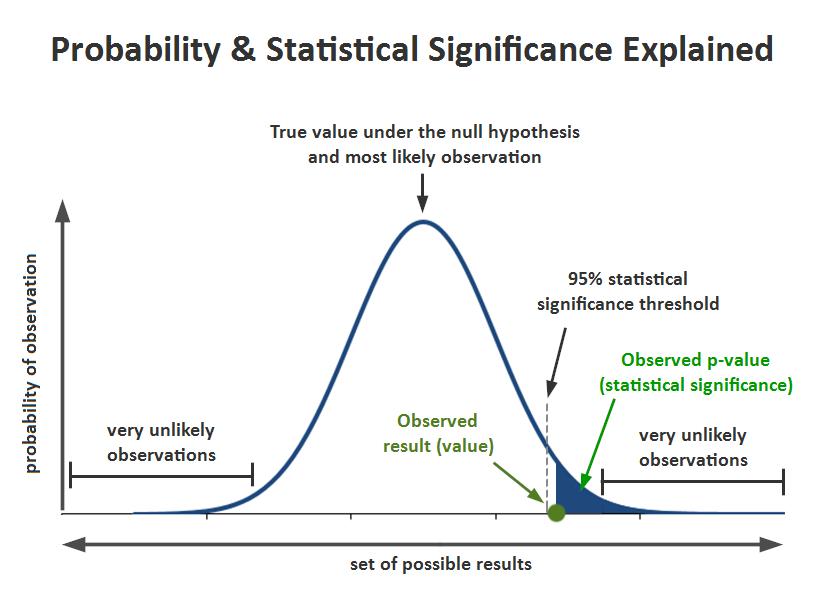
probability. There is always the possibility that differences you see when measuring a sample are just the result of random variability (“background noise”) or just dumb luck. This is sampling error. Probability is just that, the likelihood of something actually happening. The higher the probability of a specific event or outcome, the more likely it is to happen. However, remember that while you may have a high probability, you cannot guarantee certainty. The use of a p-value of 5%, written as p < 0.05, the most commonly chosen value, means we are looking at a 5% likelihood of something happening by chance alone (i.e. a one in 20 chance of that being the result). That means that whatever we are looking at statistically, the results are 95% due to what we are testing, be that a new drug, vaccine, treatment or surgery.
The take home message. Once testing and analysis are complete, a p-value that is low indicates a statistically significant difference. However, that does not
GRAPHIC COURTESY DR. JACKIE SMITH.
mean the difference will automatically be important or useful. For practical significance (i.e. noteworthy), we need to determine if the difference is large enough to actually be meaningful. A relatively large difference would be useful and practical. A small difference might not be worth the effort or cost for only a small impact. This can cause issues with regard to the interpretation of results and what decisions to make based on the data. We will be discussing these issues and concerns in future stories in this publication, so watch for our future articles.
| Jackie Smith, MSc, PhD, MACE, Dipl AVES, is an epidemiologist based at the UK Veterinary Diag- nostic Lab. Emma Adam, DVM, PhD, DACVIM, DACVS, based at UK’s Gluck Center and Veterinary Diagnostic Lab, is responsible for research and serves as veterinary industry liaison.
The Asian longhorned tick, which preys on a variety of hosts including humans and wild and domestic animals, has been found in Kentucky. This new tick is known to attack animals in large numbers and will be a concern to livestock producers, wildlife enthusiasts and pet owners. “This tick is an aggressive biter and frequently builds intense infestations on domestic hosts that can cause stress, reduced growth and severe blood loss,” said Jonathan Larson, PhD, UK extension entomologist in the College of Agriculture, Food and Environment. “One reason for their rapid buildup is that the female ticks can lay eggs without mating. It only takes a single fed female tick to create a population of ticks. Potentially, thousands can be found on an animal.” The tick has been found in small numbers on elk in Martin County and black bear in Floyd County. It was found in large numbers on a bull in Metcalfe County in the south-central part of the state. “The Metcalfe County ticks were submitted by a veterinarian who answered a call about a bull so infested that it was showing signs of severe fatigue,” said Anna Pasternak, UK entomology graduate student who manages the Kentucky Tick Surveillance Program. “The tick samples that the veterinarian submitted for identification to the UK Veterinary Diagnostic Laboratory contained Asian longhorned ticks.” Pasternak and Monica Cipriani, a student in the UK College of Public Health, sampled the Metcalfe County field and found more Asian longhorned ticks. “With the first two findings being in Eastern Kentucky, the
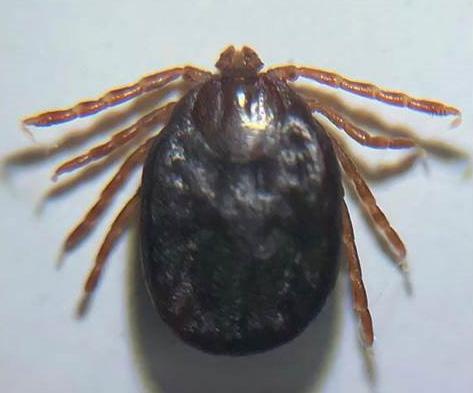
Metcalfe County finding is particularly troubling as it means the tick may have already spread farther across the state,” Pasternak said. A native of Asia, the tick was first found in 2017 in the United States. In addition to Kentucky, it has been confirmed in Arkansas, Delaware, Connecticut, Maryland, New Jersey, New York, North THE ASIAN LONGHORNED TICK WILL ATTACK WILD AND DOCarolina, Pennsylvania, MESTIC ANIMALS AND HUMANS. PHOTO COURTESY ANNA South Carolina, Tennessee PASTERNAK, UK ENTOMOLOGY GRADUATE STUDENT. and West Virginia. In adstock viral, bacterial and protozoan agents. Scientists are conducting tests on ticks collected in the United States, and it is likely that some ticks will contain germs that can be harmful to animals. Individuals who find a usually dition to cattle, black bear large number of ticks on their pet and elk, it preys on deer, raccoons, or livestock should contact their opossums, cats, dogs, coyotes, local veterinarian. Those who find foxes, sheep, goats, groundhogs, single ticks they think might be horses, Canada geese, chickens, an Asian longhorned tick should cottontail rabbits, red-tailed hawks work with their county extension and skunks. As it gets further agent for agriculture and natural established in the state, the tick is resources to submit the sample expected to have adverse effects on to UK entomologists for positive the state’s deer and wildlife popuidentification. lation. Humans also are a host. Additional information on tick bite prevention and proper tick removal Individuals who find a usually is available in UK entomology’s large number of ticks on their ENTFACT 618: Ticks and Disease pet or livestock should contact in Kentucky. It is available online their local veterinarian. at https://entomology.ca.uky.edu/ The tick is small and redextension office. dish-brown with no distinctive markings to make it easy to identify. Making detection more difficult, unfed Asian longhorned adults are smaller than other common adult ticks found in Kentucky. It is also a known or suspected vector of several important live| Source: July 21, 2020 College of Agriculture, Food and Environment news release. Katie Pratt is an agricultural communications specialist in UK’s College of Agriculture, Food and Environment. ef618 or by contacting a local
UK GLUCK CENTER’S HOSSAM EL-SHEIKH ALI AND CARLEIGH FEDORKA WIN PRESTIGIOUS AWARDS
DR. HOSSAM EL-SHEIKH ALI, LEFT, AND DR. CARLEIGH FEDORKA, RIGHT. PHOTOS COURTESY UK COLLEGE OF AGRICULTURE, FOOD AND ENVIRONMENT.


The University of Kentucky Gluck Equine Research Center had a very strong presence at the Annual Society of Theriogenology Conference, which began virtually July 23. Hossam El-Sheikh Ali, PhD, won the Dr. Jerry Rains Memorial Abstract Competition for the best presentation with “Transcriptomic analysis of equine chorioallantois reveals key regulators and pathways involved in ascending placentitis.” Carleigh Fedorka, PhD, was second with “The effect of mycobacterium cell wall fraction on histological, immunological and clinical parameters of equine postpartum involution.” More information about the conference can be found here.
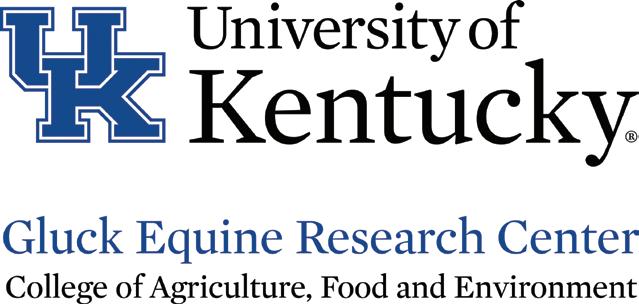
Forage Timely Tips:
Do NOT graze cool-season pastures closer than 3 to 4 inches. This will help conserve soil moisture and prevent overheating of the crowns. If drought conditions limit pasture growth, close off pastures and feed hay in a sacrifice area. Graze warm season annuals or perennials to allow cool season grasses to recover and to avoid endophyte-infected fescue. After the first good rain in August, seed winter annuals (such as small grains, ryegrass, crimson clover and brassicas) for late fall and early spring grazing. Plant alfalfa after the first good rain in August to allow sufficient size going into winter and reduce potential for sclerotinia damage. Consider renovation of cool-season grass pastures that have thinned.
Source: University of Kentucky Forage News, July 31, 2020
In late July, I had the opportunity to speak with Jennifer Cain, a doctoral candidate in the parasitology laboratory of Martin Nielsen, DVM, PhD, in the University of Kentucky Department of Veterinary Science at the Gluck Equine Research Center, about her work as a graduate research assistant and her career plans.
Before joining the parasitology lab, Cain already had a rich work history. She worked in the Kentucky State Police Forensics Labs as a forensic biologist and served in the U.S. Army as a public health official, including a posting to South Korea. She has published two research papers in peer-reviewed journals, given multiple presentations and received funding for a pilot study from the National Center for Veterinary Parasitology. Cain and her husband own a 25-acre farm near Danville, Kentucky, where she keeps her two Off-The-Track-Thoroughbreds. She has two mares, a gray mare named Sterling, who she shows in jumpers and dressage, and a new project mare, Cecilia, who is going to be a hunter.
Can you describe your main responsibilities in the parasitology lab?
I help oversee and mentor undergraduate research projects, write grants and publications, attend and present at research conferences, help collect samples and work with horses at the research farm and work on my own research. I just had one paper published and two more that I am working on, as well as three grants that are being submitted this summer/fall. My main project, which is my dissertation project, is focused on the microbiome of the equine roundworm, Parascaris spp. Currently, I am characterizing the microbiome of female and male parasite gonad and intestine. I plan to do the same for the whole organism microbiome at difference life stages, as well as some in vitro drug studies to see how anthelmintics and antibiotics affect parasite viability and their microbiome, and how those two things correlate. The goal is to determine if there are any bacteria that may be important for parasite survival, and therefore potential drug targets.
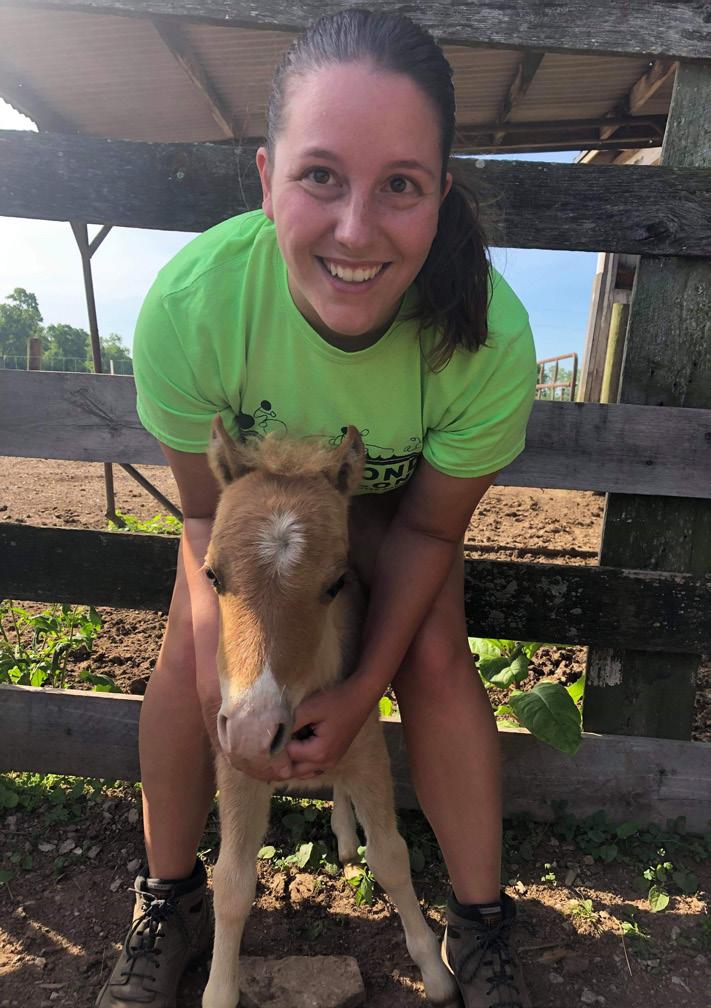
What interested you in this area of research? How did you get the opportunity to work for Dr. Nielsen?
My master’s degree was through a distance program while I was in the U.S. Army and stationed at Fort Polk, Louisiana. I chose to do a research project as part of my program, and since there is a large population of feral horses at Fort Polk, I figured they would make great candidates for research. The base veterinarian, Katie Jarisch, DVM, helped me come up with a parasitology project that would allow me to collect good data without having to come into contact with the horses. I spent a few months staring at these feral horses and collecting their feces for the project, and in the process of developing the project and writing the paper for it, I cited a large amount of Dr. Nielsen’s papers. I knew I wanted to get my Ph.D. at UK because I’ve wanted to live in Lexington my entire life, so I started contacting people in the biology department as well as forestry due to an interest in wildlife biology. I was directed to
PHOTO COURTESY JENNIFER CAIN.
Gluck and Dr. Nielsen, although I was not very confident that I would be accepted. I emailed Dr. Nielsen and we chatted on the phone, and he said he would be happy to have me in his lab. The rest is history!
How would you describe the lab? What are you most proud of?
We have a fantastic lab family. We take a large number of undergraduates to help with lab work and also provide many opportunities for people to do their own projects. Many of them have ended up with publications. That is something I never had a chance to do as an undergraduate, and I think it’s really great that we give people those opportunities. Dr. Nielsen makes all of this possible. He is a fantastic mentor and has created a great lab environment that develops wonderful scientists, with a sprinkling of fun.
What equine parasite worries you the most? Why?
I would not necessarily say that any equine parasite in particular worries me – I use strategic deworming practices for my two mares at home and otherwise am not concerned about parasites. The most pathogenic parasites of horses, however, is Strongylus vulgaris, a large strongyle. While it has been essentially eliminated from domestic horses due to the efficacy of ivermectin and early treatment practices targeting it in particular, there are still reservoirs of this parasite. Domestic horses that are not treated, such as our research herd, may have this parasite, as well as feral horses, such as those at Fort Polk. Feral horses that are adopted out could be of particular concern because they may shed S. vulgaris eggs on pasture, which is why it is important to include parasite concerns in quarantine procedures overseen by a veterinarian when introducing feral horses into domestic herds.
What do you think most horse owners get wrong about parasites?
That they are these big scary monsters out to kill their horses and must be eliminated at all costs. Cyathostomins are found in horses worldwide, and are mild pathogens that only cause clinical disease when burdens are high, so the goal of management programs is just that – management, rather than elimination.
PHOTO COURTESY JENNIFER CAIN.
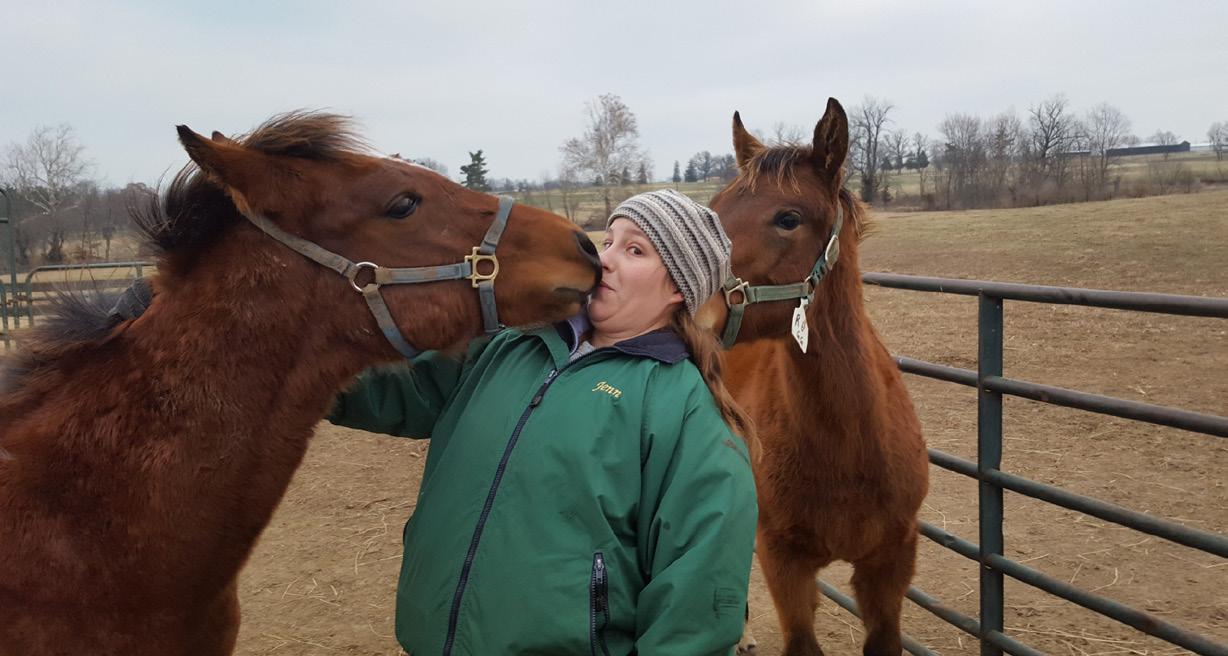
What developments or changes do you see in the coming years for deworming protocols? Do you think people will deworm more effectively? Will better/ different dewormers be available?
Well, I’m hoping that we see people move more toward management programs that use fecal egg counts and reduce the number of anthelmintic treatments used. Essentially, I hope people follow the American Association of Equine Practitioners guidelines. This is how we will preserve currently effective anthelmintics for as long as possible, and how horse owners can ensure they are using products that are still effective. We certainly hope that new products will be available, because the situation right now regarding drug efficacy and anthelmintic resistance is not great.
What parts of your job do you love? What do you like least?
I love the variety. We have a lab that is focused on equine parasites, but we do many different types of projects revolving around them, from basic biology to immunology to gene expression and beyond. I think it is very beneficial to have the exposure to a variety of different fields despite being heavily focused on only a few groups of equine-specific parasites. The back end of the horses is the part that I like the least!
Do you get to do a lot of fieldwork?
Yes! We work with our research horses weekly. We have a herd of mixed-breed full-size horses that have not been dewormed since 1979, and a herd of miniature horses whose parasites are doubledrug resistant.
Once you’ve completed your Ph.D., what do you hope to do?
I’ve discovered a passion for scientific writing and editing in
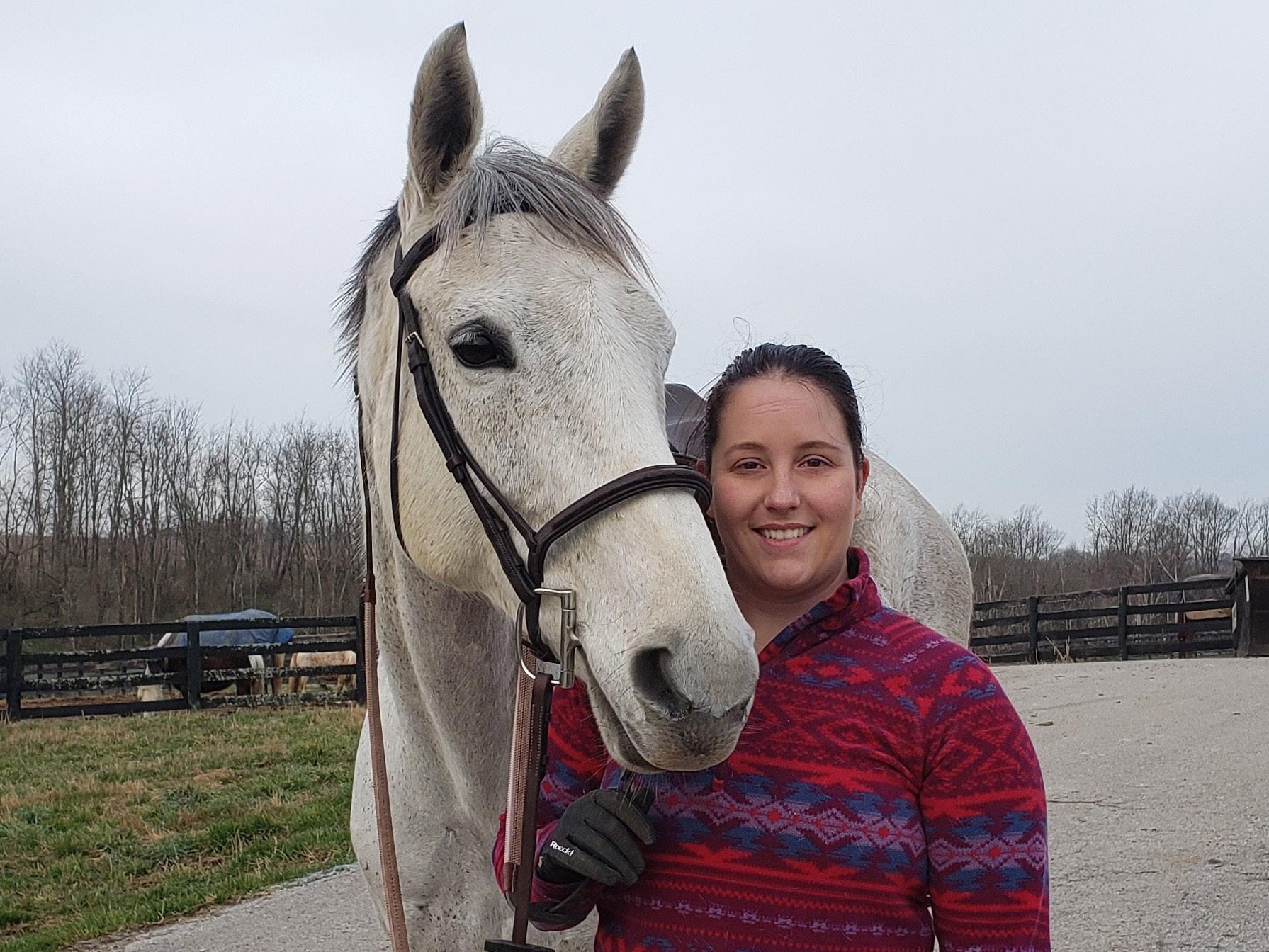
PHOTO COURTESY JENNIFER CAIN.
UK is a land-grant university. What part of the three missions (academics, research, Extension) do you actively work on? Are you looking forward to writing, research, teaching, outreach or perhaps a combination?
Research and extension services are our main focuses. Naturally, my Ph.D. is focused on research, but we also do a lot of outreach work in our lab. We go to some of the large Thoroughbred farms in the area and talk to them about their parasite control programs, which has led to some really amazing opportunities to talk to well-known people in the Thoroughbred industry, as well as meeting some famous horses.
What are some of your plans for the next year, either in the lab/school, with your horse and/or personally?
Next year I will be attending the American Association of Veterinary Parasitologists conference in Lexington, the World Association for the Advancement of Veterinary Parasitology conference in Dublin, Ireland, and the Equine Infectious Diseases conference in Normandy, France.
I plan on showing Sterling in the 2’6” – 2’9” jumpers, and Cecilia in the green horse hunter cross rails. Hopefully we will do well at TIP Championships!
| Karin Pekarchik, MS, senior extension associate for distance learning and founder of the UK Female Equestrian Health and Wellness Community of Practice, provided this information.
WATCH FOR BLISTER BEETLES IN HAY
THE RED HEADED BLISTER BEETLE (LEFT) AND MARGINED BLISTER BEETLE (RIGHT) ARE COMMON SPECIES IN KENTUCKY. SOURCE: UK COLLEGE OF AGRICULTURE, FOOD AND ENVIRONMENT.

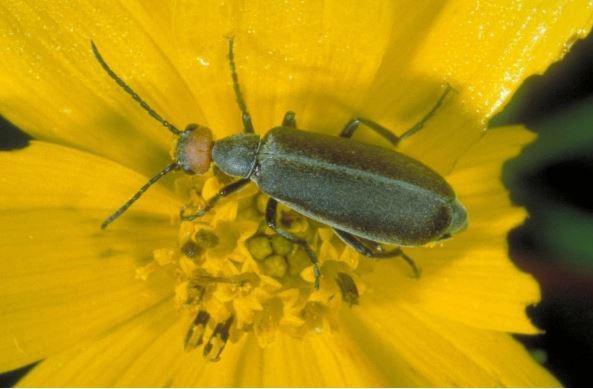
Blister beetles are sometimes found in mid-summer cuttings of alfalfa hay and can be toxic if consumed by livestock, especially horses. As few as five to 10 of these beetles can be fatal to horses when ingested because of the cantharidin in their hemolymph (insect blood).
Management to minimize blister beetle problems in alfalfa: • Cut alfalfa at 10% or less bloom • Manage weeds in and around fields, especially pastures • Consider cropping practices adjacent to alfalfa. Blister beetles can be abundant in soybeans but are usually absent in corn. • Do not grow solanaceous crops near alfalfa – both black and stripped blister beetles can be abundant in tomatoes and potatoes • Sample field margins before cutting – blister beetles usually come from field margins and do not tend to move too far beyond the edges of alfalfa fields • Monitor pastures for grasshoppers. Several blister beetle species develop in grasshopper egg pods. A high grasshopper population can produce high blister beetle numbers the following year.
Ric Bessin, PhD, extension professor, and Lee Townsend, PhD, emeritus extension professor, both from the Department of Entomology, provided this information. Excerpted from Kentucky Pest News. Source: July 31, 2020, Kentucky Forage News.




